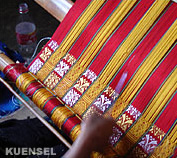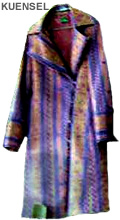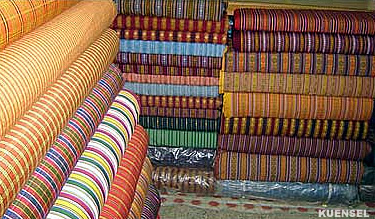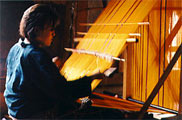 |
Bhutan's
Economy: Textile Industry |
 |
Bhutan
Information |
|
|
 |
|
Traditional
all the way
|

|
It
is six in the morning and Kesang Pelmo, 17, is busy at work. Strapped to
the loom and her head bend low her fingers move dexterously to weave patterns
on the colourful warp. Kesang is weaving a gho piece.
 |
A traditional weave in the making
| The
weave is simple and Kesang is confident the piece will be done in a few
days time and fetch her not less than Nu. 3,000 - an amount enough to buy
a month's ration.
Tshering
Dema, a divorcee and a mother of three children, is a full time weaver,
employed in one of the weaving centres in Thimphu. With a monthly income
of Nu. 3,000 Tshering says it is difficult to meet ends. |
|
In
a country which is often known as the 'land of weaving and textiles', it
is common to see rural women, especially in eastern Bhutan, weaving different
fabrics during the lean farming season. The woven is not only for self-usage
but also to supplement household income.
Over
the years, the latter has transformed as a sole reason for more and more
women, mostly housewives, in urban towns to take up weaving.
Karma,
32, decided to put her weaving skills into practice when her husband's
monthly income of Nu.3,000 was not enough to meet the expenses. Now, Karma
who has been weaving since the age of 12, earns an average of Nu.6,000
a month. "It is good money to run the house and meet the children's demands,"
says Karma.
Most
weaving housewives said that their modest earning made a 'real'
difference in times of need.
Wangmo
who has been weaving since the age of 12, had to give up her practice when
she became a mother. And she can feel the impact. "At least when I was
weaving we did not have financial problems," says Wangmo.
Housewives
also share the view that weaving gave them a sense of independence. "We
do not have to be dependent entirely on our husbands for every little thing,"
says Yangzom.
The
weaving culture is gaining ground with more and more rural women, with
fine weaving skills, moving into towns in search of better livelihood.
These women either work for individuals at a minimum wage, weave and sell
through friends or work full time in numerous weaving centres in town.
Tshering,
39, works at one of the weaving centres in Thimphu and earns between Nu.2,500
and Nu.3,000, depending on the weave pattern. Her weave is mostly plain
kiras and ghos for men.
The
business, according to many, was doing well with the trend for woven kiras
suddenly making a come back.
Explains
Yangzom, 47. "There was a time when woven kiras and ghos faced stiff competition
from the factory created fabrics abundantly found in shops which was comparatively
cheap. But now men and women prefer the woven fabric to factory made."
top
 |
traditional dress
| Most
of the customers are young office goers who do everything to remain trendy.
Half kiras in classic patterns like moentha, mathra and even the simple
karchang are popular buys among the young lot. The price for these range
between Nu.800 and Nu.1,200 a piece.
Cashing
in on the trend, weavers earn an average income of about Nu.400 - Nu.5,000
a month, depending on the intricacy of designs, the quality of the yarns
and the finesse of the product.
Considered
one of the 13 crafts of Bhutan, the entire weaving process takes between
a week and a year, and it is not easy. |
|
Threads are dyed (using vegetable
dye) and dried for weeks and smoothened before being woven into fabric
which itself is an intricate process. The finest weaves are inarguably
from Lhuentse and Trashigang in eastern Bhutan.
Most
weavers said that the demand is higher for karchang (plain kira) and kiras with simple motifs. The mechi (Assamese) woven kiras and
ghos, which stormed the Bhutanese textile market some years ago, still
rule the market. The price, however, has fallen sharply from the initial
Nu.1,200 to Nu.500. The wearers find the weave light and manageable.
top
 |
Cheaper factory-made version
| The
overly indulgent, however, unflinchingly spent thousands on fabrics in
pure silk. The silk choice are mostly among the elite and the tourists
who find the intricate patterns in colourful designs impressive.
The
Handicrafts Emporium in Thimphu is one such outlet where tourists hoard
to buy the beautiful textiles. |
|
The Emporium bought the textiles from the
Khaling Handloom Development Center which employed about 370 weavers and
also from the wives of army and police personnel.
Besides
the kiras and ghos, other items like tablecloths, bags, and stoles in pure
and raw silk and terry-cotton are popular buys. "Someone or the other always
buy your stuff," says Wangmo. "If you can keep track of the trend in demand
and can produce constantly there is no dearth of buyers."
Of
late, numerous ventures have tried to diversify and evolve the traditional
weave. Phuonge Doan, an experienced tailor and a designer is one among
the few who started the Mawongpa group, which give young Bhutanese tailoring
and designing course in western and traditional outfits. The outfits are
sold priced between Nu. 1,000 and Nu. 22,000. "There is a huge scope for
Bhutanese textiles, be it in the western designs or traditional," says
Phuonge Doan.
| By
Kinga Dema, KUENSEL, Bhutan's National Newspaper 2007 |
 |
|









